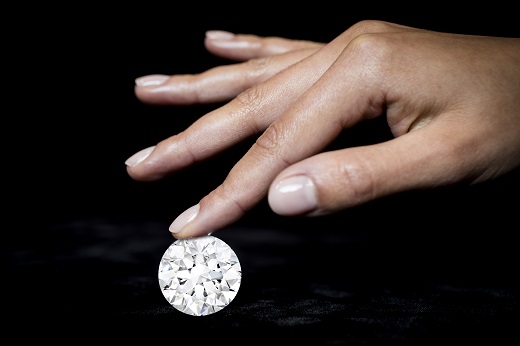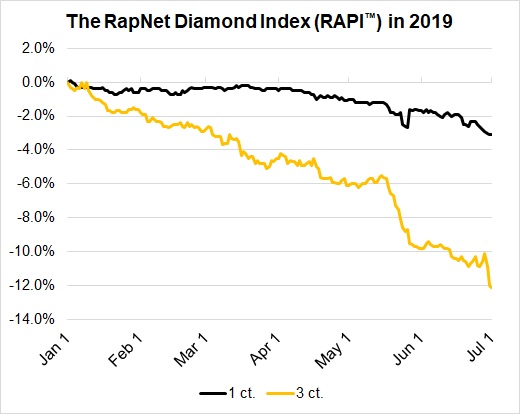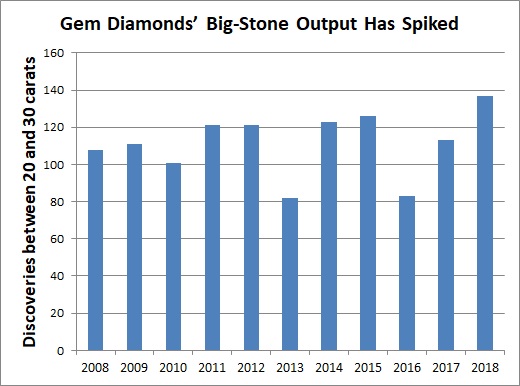|
|
Why the Market for Large Diamonds Is in Free Fall
Four factors are driving the slowdown
Jul 2, 2019 11:37 AM
By Joshua Freedman
|
|
|

RAPAPORT... As the who’s who in the glitzy world of high-value
diamond auctions gathered in Geneva in May, there was an understated tone to
this year’s pilgrimage to the Swiss city. While Sotheby’s and Christie’s played
up their offerings of magnificent jewels, which usually boost market sentiment
with the records they set, dealers approached the sales with some trepidation.
The big-stone market, they noted, has seen better days.
The major auction houses are setting lower reserve prices
than before in response to the weakness, explained Johnny Kneller, CEO of
big-stone manufacturer Safdico.
At the Christie's Geneva auction, a 12.50-carat, D-color, VVS1-clarity, potentially internally
flawless rectangular diamond sold for “just” $68,000 per carat. While the stone had non-ideal
proportions, the price reflected a serious slowdown in the big-stone sector, stressed
Thomas Faerber, a jewelry dealer and co-founder of the GemGenève trade show. The final price was 27.5% off the Rapaport Price List, according to Faerber’s calculations.
“Apart from the 77% depth, it was a beautiful stone, and
I would have expected it to fetch around list price in a better market,” Faerber
added.
The sale was not an exception. Prices of large stones
have been plummeting for six months as an array of challenges have dented
sentiment, with each discounted sale setting off alarm bells in the trade,
knocking confidence further. The RapNet Diamond Index (RAPI™) for 3-carat stones
dropped 12% in the first half of 2019, compared with a 3.1% decline for the
1-carat category.

“It’s a vicious circle,” a rough broker said on condition
of anonymity. “Some people are expecting prices to come down further, so are
delaying their purchases. The one leads to the other.”
Dealers identified four main factors contributing to the
downward spiral.
1. Tight liquidity
In the past six months, larger Indian companies have been
offloading polished diamonds above 3 carats to raise capital, the anonymous
broker observed. That has weakened sentiment in the market, and created
expectations that prices will fall further. Retailers don’t want to make
purchases when they expect prices to continue their descent, he observed.
“They had to raise cash rather quickly, and to raise that
cash in pointer [sizes] doesn’t make any sense, as it takes you way too long,” the
broker explained. “There have been quite a few players offering these [large] goods
at serious discounts on the market, and as a consequence, people have lost
confidence in that product.”
A few low-price transactions can have a wide, negative
impact on trading, explained Safdico’s Kneller, who echoed the rough broker’s
explanation of the slowdown. The large-stone market is relatively small, so
knowledge of a new price benchmark spreads fast.
“The prices were pushed up by speculators with easy
credit, and have now dropped as the speculators face liquidity problems,”
Kneller said.
2. Stricter compliance
While improved transparency is helping clean up the
trade, it has contributed to the high-end slowdown, dealers acknowledged. Individuals
who previously stored illicitly obtained wealth in diamonds are no longer able
to do so with such ease, a director of an Antwerp-based diamond company noted. Governments
are cracking down on the black market, and banks are asking for more
documentation to prove the legitimate origin of goods and funds.
In particular, it’s become more difficult to trade with
Hong Kong, as the municipality has stepped up its compliance rules in an effort
to improve its global reputation, traders reported. Companies with longstanding
banking relationships find their lenders are questioning income and asking for
proof of transactions.
“The strict
regulation of money is not having a positive effect on [the industry],” said
Ephraim Zion, founder of Hong Kong-based high-end jeweler Dehres. “It’s [an
issue] all over the world, but it’s more pronounced here in Hong Kong.” There’s
a direct connection between the compliance challenges and the price of large
diamonds, he insisted.
Meanwhile, US sanctions against certain individuals who
previously bought diamonds have taken some important clients out of the market,
another diamantaire said.
3. Reduced rarity
One ironic influence is mining companies’ success recovering
rough. Improvements in technology have helped producers keep large stones
intact when extracting them, affecting the rarity of those valuable diamonds,
traders told Rapaport News. That’s the case both for 10-carat-plus rough,
and for the extraordinary pieces above 100 carats.
“When you’ve got dozens — and I mean dozens — of diamonds
that are coming out of the mines right now,…they’re not so rare anymore,” said
Alan Bronstein, owner of New York-based Aurora Gems and president of the
Natural Color Diamond Association.

Source: Gem Diamonds company reports
Gem Diamonds found 15 stones over 100 carats at its
Letšeng mine in Lesotho last year, beating its previous record of 11 in 2015.
It also recovered 137 diamonds between 20 and 30 carats, compared with 113 in
2017. Lucara Diamond Corp., another big-stone specialist, has unearthed 12
diamonds above 300 carats since commissioning new X-ray-transmission (XRT)
technology at its Karowe mine in Botswana in 2015, it reported in April. Lucara
sold a total of 153 diamonds above 10.8 carats in 2018, compared with 115 in
the previous year.
“We’ve heard from
competent people that there are more large, D-flawless diamonds on the market,”
said Faerber, who noted slower sales by some GemGenève
exhibitors due to the situation. “The way to
extract these stones has become more sophisticated.”
One anonymous dealer said he personally knew of seven or
eight 20-carat, D-flawless polished diamonds. In the past, the number of such
stones available would have been significantly smaller. That has made wealthy
individuals perceive the product as a less exclusive option than before.
“Prices of diamonds have been falling so steadily over
the last few years that people don’t view it as an asset class anymore,” he
said.
4. Economic uncertainty
The tariff dispute between the US and China has
aggravated the decline in the past six to 12 months, according to the same
anonymous diamantaire.
“One of the main reasons [for the big-stone slump] is
that people want to conserve their wealth,” he said. “The trade wars aren’t
helping.”
High-end consumer demand in the US — on which the
large-stone market partly relies — has also been shaky. The public is now more
aware of price “bubbles” after seeing what happened during the 2008 financial
crisis, according to Elisabeth Austin, founder of Diamond Runway, which helps
connect jewelry and gem sellers with collectors. At the same time, the wealthy
are no longer comfortable being seen wearing super-expensive items, she
observed.
“The only people in the US who are displaying things of
high value are seemingly the rapper and reality-TV community, which the
high-end people do not want to emulate,” Austin said. “So we’re still struggling
to successfully represent high end to the high-net-worth individuals in the
US.” The uncertainty has forced diamond suppliers to carry more large-stone
inventory than they would normally want, she added.
Big stones, little optimism
The trade can expect key buyers to sit out for the time
being as they see little hope for improvement in the short term. For instance,
consortiums that previously bought supersized rough through profit-sharing
arrangements are likely to restrict their spending, predicted Bronstein at
Aurora Gems.
“The syndicates are overextended, because they’re sitting
on hundreds of millions or billions of dollars of rare gems that have nowhere
to go,” he said. “They’re also going to be quiet unless they can get a bargain.”
With so many things affecting the market, a lot will have
to change if confidence is to return. Last week’s agreement by the US and China
to resume trade talks could boost overall sentiment, but the other factors will
remain. And dealers will need to find a way around those challenges.
Better marketing is one partial solution, as consumer
demand is currently out of kilter with the huge quantities of large diamonds
coming out of mines, Dehres’s Zion argued.
“As long as there is an imbalance between supply and
demand, things will not improve dramatically,” he concluded.
Image: A round brilliant, 102.34-carat, D-color, flawless
diamond Sotheby’s sold privately in 2018 for an undisclosed price. (Sotheby’s)
|
|
|
|
|
|
|
|
|
|
Tags:
Auctions, big diamonds, Big stones, Christie’s, Gem Diamonds, Joshua Freedman, large diamonds, large stones, Lucara Diamond Corp., prices, Rapaport News, Sotheby’s
|
|
|
|
|
|
|
|
|
|
|

|
|